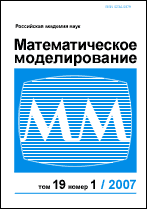|
Aspects of computer simulation of transport and cleaning processes from cuttings in horizontal well sections
S. N. Kharlamova, M. Janghorbania, M. R. Bryksinb
a National Research Tomsk Polytechnic University
b Branch of Gazprom Invest Tomsk Limited Liability Company
Abstract:
The relevance of research is related to the need to form clear ideas about the factors of
successful drilling operations and make a number of generalizations to existing methods
for predicting the transport and cleaning of wells with a horizontal section, taking into
account the features and patterns of drilling fluid flow in real drilling modes. The purpose
of the work: to study the features of the spatial flow of a mixture of drilling fluid with
solid particles in the coaxial and eccentric areas of the well; to establish the patterns of
the developing steady flow of the mixture through the well; to issue recommendations for
the practice of applied calculations for the improvement of the well cleaning process by
hydraulic methods. A well with a 12-meter horizontal eccentric section was chosen as the
object of study, in which the flow is carried out under conditions that are as close as possible to actual drilling parameters. The universal key to understanding the features and
identifying the patterns of the processes considered in the work are the methods of mechanics of inhomogeneous continuums for viscous homogeneous and heterogeneous
mixtures, computational fluid dynamics (CFD) combined with the ideas of a complex
physical, mathematical and numerical study of internal flows of rheologically complex
viscous media. It has been established that particles can significantly affect the structure
of the averaged and pulsating flow of a droplet liquid, their settling leads to the formation
of an inhomogeneous anisotropic flow structure, the calculation of which requires modern two parameter turbulence models for Reynolds stresses. It is shown that in the bottom
region of the annular space there is a zone with equivalent phase velocities, where the effects of a decrease in the intensity of molar transfer are manifested with an increase in the
size of the sediment layer. Real drilling conditions are characterized by processes that accompany laminarization and stabilization of the mixture flow along the entire length of
the well; near the boundary of the fixed layer of settled particles, a narrow layer of their
suspended state is formed. Moreover, the flow of cuttings particles from the reservoir
surface, as well as their transition to a suspended state, is mainly determined by convective-diffusion mechanisms, the intensity of the pulsating small-scale movement of vortices with an anisotropic structure, and the presence of local areas with “moderately
high” flow velocities in contact with a curvilinear unstable to small disturbances section
surface. The conditions for the formation of a stagnant zone, in which sedimentation and
growth in the size of deposits are intense, are noted. In practice, a technology and algorithm for modeling the process of interaction of two-phase flows with the walls of an eccentric pipe, based on demonstrations of CFD capabilities, is recommended. As well as
conclusions on improving the criterion relationships for determining the minimum flow
rates of the drilling fluid, taking into account the correction of parameters characterizing
the rheological features of the mixture, the intensity of turbulence, the geometry of the
annular space and connecting nodes.
Keywords:
well, drilling, annular flows, eccentricity, rotation, core, simulation, hydrodynamics, rheology, heterogeneity, turbulence, closures, cuttings, transport, sedimentation, cleaning.
Received: 27.06.2022
Revised: 27.06.2022
Accepted: 12.09.2022
Citation:
S. N. Kharlamov, M. Janghorbani, M. R. Bryksin, “Aspects of computer simulation of transport and cleaning processes from cuttings in horizontal well sections”, Matem. Mod., 34:11 (2022), 77–106; Math. Models Comput. Simul., 15:3 (2023), 502–519
Linking options:
https://www.mathnet.ru/eng/mm4420 https://www.mathnet.ru/eng/mm/v34/i11/p77
|

|




 Contact us:
Contact us: Terms of Use
Terms of Use
 Registration to the website
Registration to the website Logotypes
Logotypes








 Citation in format
Citation in format 